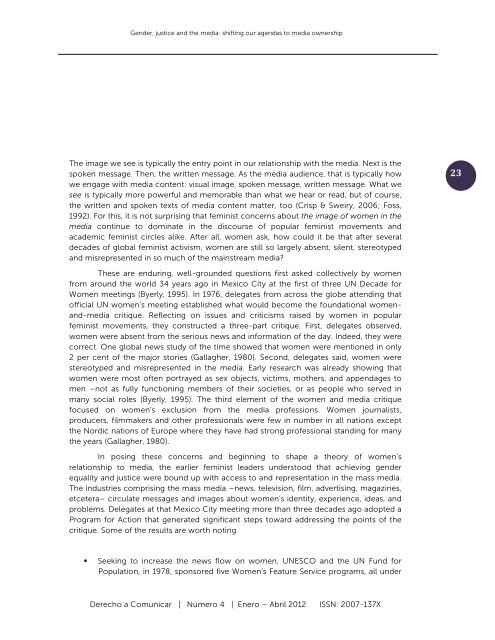21aiiMmFK
21aiiMmFK
21aiiMmFK
Create successful ePaper yourself
Turn your PDF publications into a flip-book with our unique Google optimized e-Paper software.
Gender, justice and the media: shifting our agendas to media ownership<br />
The image we see is typically the entry point in our relationship with the media. Next is the<br />
spoken message. Then, the written message. As the media audience, that is typically how<br />
we engage with media content: visual image, spoken message, written message. What we<br />
see is typically more powerful and memorable than what we hear or read, but of course,<br />
the written and spoken texts of media content matter, too (Crisp & Sweiry, 2006; Foss,<br />
1992). For this, it is not surprising that feminist concerns about the image of women in the<br />
media continue to dominate in the discourse of popular feminist movements and<br />
academic feminist circles alike. After all, women ask, how could it be that after several<br />
decades of global feminist activism, women are still so largely absent, silent, stereotyped<br />
and misrepresented in so much of the mainstream media?<br />
23 <br />
These are enduring, well-grounded questions first asked collectively by women<br />
from around the world 34 years ago in Mexico City at the first of three UN Decade for<br />
Women meetings (Byerly, 1995). In 1976, delegates from across the globe attending that<br />
official UN women’s meeting established what would become the foundational womenand-media<br />
critique. Reflecting on issues and criticisms raised by women in popular<br />
feminist movements, they constructed a three-part critique. First, delegates observed,<br />
women were absent from the serious news and information of the day. Indeed, they were<br />
correct. One global news study of the time showed that women were mentioned in only<br />
2 per cent of the major stories (Gallagher, 1980). Second, delegates said, women were<br />
stereotyped and misrepresented in the media. Early research was already showing that<br />
women were most often portrayed as sex objects, victims, mothers, and appendages to<br />
men –not as fully functioning members of their societies, or as people who served in<br />
many social roles (Byerly, 1995). The third element of the women and media critique<br />
focused on women’s exclusion from the media professions. Women journalists,<br />
producers, filmmakers and other professionals were few in number in all nations except<br />
the Nordic nations of Europe where they have had strong professional standing for many<br />
the years (Gallagher, 1980).<br />
In posing these concerns and beginning to shape a theory of women’s<br />
relationship to media, the earlier feminist leaders understood that achieving gender<br />
equality and justice were bound up with access to and representation in the mass media.<br />
The industries comprising the mass media –news, television, film, advertising, magazines,<br />
etcetera– circulate messages and images about women’s identity, experience, ideas, and<br />
problems. Delegates at that Mexico City meeting more than three decades ago adopted a<br />
Program for Action that generated significant steps toward addressing the points of the<br />
critique. Some of the results are worth noting<br />
<br />
Seeking to increase the news flow on women, UNESCO and the UN Fund for<br />
Population, in 1978, sponsored five Women’s Feature Service programs, all under<br />
Derecho a Comunicar | Número 4 | Enero – Abril 2012 ISSN: 2007-137X



